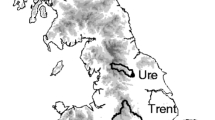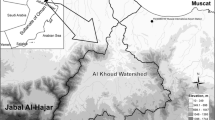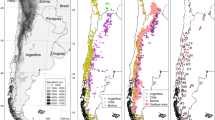Abstract
We examine trends and variability in low flows over the eastern U.S. (S. Carolina to Maine) and their attribution in a changing climate. We select 149 out of 4878 USGS stations over the eastern U.S., taking into account data availability and minimal direct management. Annual 7-day low flows (Q7) are computed from the series of daily streamflow records for 1962–2011 and compared to an antecedent precipitation (AP) index calculated over the corresponding basin for each station. In general, a north–south (increasing-decreasing) dipole pattern in low flow trends is associated with trends in AP. The exception is in the southern part of the study area including Virginia and the Carolinas, where moderate increasing trends in AP may have been offset by water withdrawals and increasing potential evapotranspiration (PET) as driven by increasing temperature and vapor pressure deficit. A principal component analysis (PCA) of Q7 and AP indicates that the North Atlantic Oscillation (NAO) and Pacific North America (PNA) pattern show statistically significant correlations for Q7 at 1 and 2 month lead time, respectively, via large-scale pressure patterns. Our findings suggest that the inter-annual variability of low flows has increased due to significant anti-correlation between the NAO and PNA during recent decades, and the future risk of low flow extremes may be further enhanced with temperature driven increases in PET and persistence of the multi-decadal relationship between NAO and PNA.







Similar content being viewed by others
References
Andreadis KM, Lettenmaier DP (2006) Trends in 20th century drought over the continental United States. Geophys Res Lett 33:L10403
Bosch DD, Lowrance RR, Sheridan JM, Williams RG (2003) Ground water storage effect on streamflow for a southeastern coastal plain watershed. Ground Water 41:903–912. doi:10.1111/j.1745-6584.2003.tb02433.x
Bradford MJ, Heinonen JS (2008) Low flows, instream flow needs and fish ecology in small streams. Can Water Resour J 33:165–180
Brutsaert W (2010) Annual drought flow and groundwater storage trends in the eastern half of the United States during the past two-third century. Theor Appl Climatol 100:93–103
Castle SL, Thomas BF, Reager JT, Rodell M, Swenson SC, Famiglietti JS (2014) Groundwater depletion during drought threatens future water security of the Colorado River Basin. Geophys Res Lett 41:5904–5911. doi:10.1002/2014GL061055
Coopersmith EJ, Minsker BS, Sivapalan M (2014) Patterns of regional hydroclimatic shifts: an analysis of changing hydrologic regimes. Water Resour Res 50:1960–1983. doi:10.1002/2012WR013320
Dingman SL (2008) Physical hydrology, 2nd edn. Prentice Hall, Old Tappan, NJ
Douglas EM, Vogel RM, Kroll CN (2000) Trends in floods and low flows in the United States: impact of spatial correlation. J Hydrol 240:90–105
Ekstrom M, Jones PD, Lenderink HJ et al (2007) Regional climate model data used within the SWURVE projects. 1: projected changes in seasonal patterns and estimation of PET. Hydol Earth Syst Sci 11:1069–1083
Eng K, Wolock DM, Carlisle DM (2013) River flow changes related to land and water management practices across the conterminous United States. Sci Total Environ 463–464:414–422
Feyen L, Dankers R (2009) Impact of global warming on streamflow drought in Europe. J Geophys Res 114:D17116. doi:10.1029/2008JD011438
Gupta RS (2008) Hydrology and hydraulic systems, 3rd edn. Prentice Hall, Upper Saddle River, NJ
Hamed KH (2008) Trend detection in hydrologic data: the Mann–Kendall trend test under the scaling hypothesis. J Hydrol 349:350–363
Hanna E, Cropper TE, Jones PD, Scaife AA, Allan R (2014) Recent seasonal asymmetric changes in the NAO (a marked summer decline and increased winter variability) and associated changes in the AO and Greenland blocking index. Int J Climatol. doi:10.1002/joc.4157
Hayhoe K, Wake C, Huntington TG, Luo L, Schwartz MD, Sheffield J, Wood EF, Anderson B, Bradbury J, DeGaetano TT, Wolfe D (2007) Past and future changes in climate and hydrological indicators in the US Northeast. Clim Dyn 28:381–407
Hughes AG, van Wonderen JJ, Rees JG et al (2012) How to get your model results used: a guide to stakeholder engagement. In: Shepley MG, Whiteman MI, Hulme PJ, Grout MW (eds) Groundwater resources modelling: a case study from the UK. Geological Society, London, Special Publications, 364, pp 39–48
Kam J, Sheffield J, Wood EF (2014) A multi-scale analysis of drought and pluvial mechanisms for the southeastern United States. J Geophys Res Atmos 119:7348–7367
Kingston DG, McGregor GR, Hannah DM, Lawler DM (2007) Large-scale climatic controls on New England river flow. J Hydrometeorol 8:367–379
Knippertz P, Wernli H (2010) A lagrangian climatology of tropical moisture exports to the Northern Hemispheric extratropics. J Clim 23:987–1003
Konikow L (2013) Groundwater depletion in the United States (1900–2008). U.S. Geological Survey Scientific Investigations Report 2013–5079
Kumar S, Merwade V, Kam J, Thurner K (2009) Streamflow trends in Indiana: effects of long term persistence, precipitation and subsurface drains. J Hydrol 374:171–183
Lins HF (2012) USGS hydro-climatic data network 2009 (HCDN–2009): U.S. Geological Survey Fact Sheet, 2012–3047, 4 p., available only at http://pubs.usgs.gov/fs/2012/3047/
Lins HF, Slack JR (1999) Streamflow trends in the United States. Geophys Res Lett 26:227–230
Livneh B et al (2013) A long-term hydrologically based dataset of land surface fluxes and states for the conterminous United States: update and extensions. J Clim 26:9384–9392
McCabe GJ, Wolock DM (2002) A step increase in streamflow in the conterminous United States. Geophys Res Lett 29. doi: 10.1029/2002GL015999
Patterson LA, Lutz B, Doyle MW (2012) Streamflow changes in the south Atlantic, United States during the mid- and late 20th century. J Am Water Resour Assoc 48:1126–1138
Pettitt AN (1979) A non-parametric approach to the change-point problem. Appl Stat 28:126–135
Pinto JG, Reyers M, Ulbrich U (2011) The variable link between PNA and NAO in observations and in multi-century CGCM simulations. Clim Dyn 36:337–354
Raible CC (2007) On the relation between extremes of midlatitude cyclones and the atmospheric circulation using ERA40. Geophys Res Lett 34:L07703
Sadri S, Kam J, Sheffield J (2015) Non-stationarity of low flows and their timing in the eastern United States. Hydrol Earth Syst Sci Discuss 12:2761–2798. doi:10.5194/hessd-12-2761-2015
Sayemuzzaman M, Jha MK (2014) Seasonal and annual precipitation time series trend analysis in North Carlina, United States. Atmos Res 137:183–194. doi:10.1016/j.atmosres.2013.10.012
Scaife AA et al (2014) Skillful long-range prediction of European and North American winters. Geophys Res Lett 41:2514–2519
Smakhtin VU (2001) Low flow hydrology: a review. J Hydrol 240:147–186
Small D, Islam S, Vogel RM (2006) Trends in precipitation and streamflow in the eastern U.S.: paradox or perception? Geophys Res Lett L03403. doi: 10.1029/2005GL024995
U.S. Geological Survey (2014) National water information system data available on the World Wide Web (Water Data for the Nation), accessed [last accessed, August 2014], at URL (http://waterdata.usgs.gov/nwis/)
Ulbrich U, Christoph M (1999) A shift of the NAO and increasing storm track activity over Europe due to anthropogenic greenhouse gas forcing. Clim Dyn 15:551–559
Wada YL, van Beek PH, Wanders N, Bierkens MFP (2013) Human water consumption intensifies hydrological drought worldwide. Environ Res Lett 8:034036. doi:10.1088/1748-9326/8/3/034036
Wanders N, Wada Y, van Lanen HAJ (2014) Global hydrological droughts in the 21st century under a changing hydrological regime. Earth Syst Dyn 6:1–15. doi:10.5194/esd-6-1-2015
Wang CZ (2002) Atlantic climate variability and its associated atmospheric circulation cells. J Clim 15:1516–1536
Wang D, Cai X (2009) Detecting human interferences to low flows through base flow recession analysis. Water Resour Res 45:W07426
Wang CZ, Enfield DB (2001) The tropical western hemisphere warm pool. Geophys Res Lett 28:1635–1638
Wilks DS (2006) Statistical methods in the atmospheric sciences: an introduction. Academic Press, 467 pp
Acknowledgments
This work was supported by the USGS (G11AP20215) and NOAA (NA11OAR4310097). The authors would like to thank Dr. Sara Sadri and Dr. Joshua Roundy for conducting the Pettit test and extracting the corresponding basin masks to the 149 stations. The authors acknowledge the TIGRESS high performance computer center at Princeton University.
Author information
Authors and Affiliations
Corresponding author
Additional information
Key findings
1. There is a north-south increasing-decreasing trend pattern in warm season low flows over the eastern U.S.
2. The trends are associated with increases in antecedent precipitation in the north and increasing PET trends and water management in the south that exceed precipitation increases.
3. Inter-annual variability in low flows is linked to the NAO and PNA, which may provide predictive skill at one to two month lead time.
Electronic supplementary material
Below is the link to the electronic supplementary material.
ESM 1
(DOCX 657 kb)
Rights and permissions
About this article
Cite this article
Kam, J., Sheffield, J. Changes in the low flow regime over the eastern United States (1962–2011): variability, trends, and attributions. Climatic Change 135, 639–653 (2016). https://doi.org/10.1007/s10584-015-1574-0
Received:
Accepted:
Published:
Issue Date:
DOI: https://doi.org/10.1007/s10584-015-1574-0




